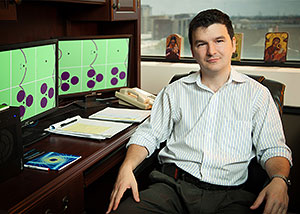Air Force Awards Young Investigator Program Grant to UH Mathematics Professor
Onofrei’s Work Addresses the Control of Electromagnetic Fields

Hear more about Daniel Onofrei’s work on KUHF’s UH Moment.The Air Force Office of Scientific Research awarded a three-year grant to University
of Houston assistant professor of mathematics Daniel Onofrei as part of their Young
Investigator Program. The program supports scientists who received a Ph.D. within
the last five years "and show exceptional ability and promise for conducting basic
research."
Onofrei's proposal, one of 40 selected, is funded for $120,000 per year beginning in April. A total of 192 proposals, from aerospace to physics and life sciences, competed for the Air Force grants.
His research addresses the control of electromagnetic fields, with an intended impact on reducing jamming threats, electromagnetic interference and unwanted electromagnetic surveillance.
"The enemy detects you by sending waves and waiting for the echo. The echo is what we call the backscattered field," Onofrei said. "Our approach is based on designing a tight cover on whatever it is you want to protect, and embedding antennas on this cover. We want to detect an incoming signal and cancel the respective echo.
The project will focus on applying mathematical equations (partial differential equations) in regards to electromagnetic waves to deter radar instead of using traditionally assumed physical shields.
"Our approach is not based on using any materials," Onofrei said. "We are using antennas."
In addition to the materials used for the antennas, Onofrei says a tight, transparent skin will cover the antennas to allow distance between them and the incoming fields.
"The skin itself will play no role in the cloaking mechanism and ideally will not interfere with the aerodynamics and communication capability," Onofrei said.
Dr. Richard Albanese, one of the best antenna specialists (formerly at Brooks Air Force Base in San Antonio), is working with Onofrei on the project.
Onofrei says the proposed method, referred in academic literature as the "active cloaking approach," comes in two forms: generating a signal to cancel the echo of the radar after it hits, and cancelling the incoming field pre-emptively.
The ultimate goal, according to Onofrei, is to control the incoming electromagnetic fields in real-time."So you don't let them hit you. There will be no echo," Onofrei said. "You detect it. You allow a glimpse at you, just enough that you can detect them. We're talking about Pico-seconds."
Onofrei added that it may be possible to use the strategy for sonar as well.
- D.L. Haydon, College of Natural Sciences and Mathematics